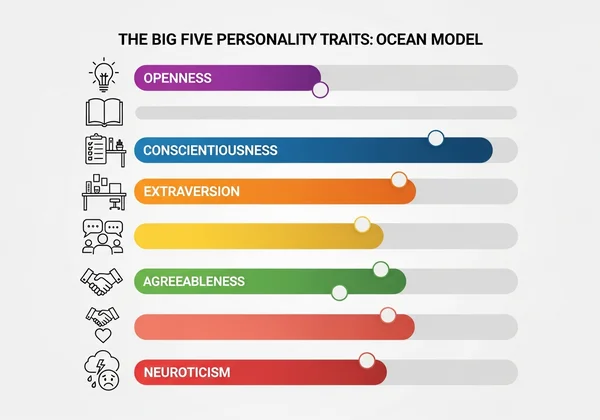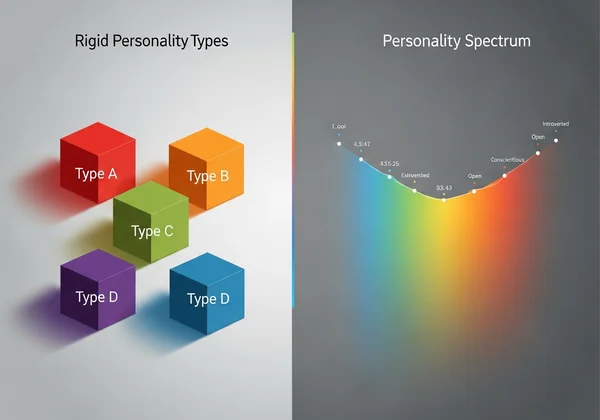The Big Five Neuroticism Test: Why Science Matters Over MBTI & Enneagram
In the vast world of self-discovery, personality tests offer a fascinating window into who we are. From the widely popular Myers-Briggs Type Indicator (MBTI) to the spiritually-inclined Enneagram, many of us have used these tools hoping for clarity. But when it comes to understanding a core trait like neuroticism, which influences our emotional stability and response to stress, what makes a personality test truly reliable? This article explores the crucial differences between popular frameworks and the scientifically validated Big Five model, highlighting why an evidence-based approach provides deeper, more actionable insights for genuine personal growth.
The journey to self-understanding deserves a foundation of accuracy. While labels can feel comforting, a precise measurement of your traits offers a clearer path forward. To begin this journey with a trusted tool, you can start your Neuroticism Test today.

Understanding Big Five Neuroticism: The Scientific Standard
Before comparing different systems, it’s essential to grasp the gold standard in personality psychology: the Big Five model, also known as the Five-Factor Model. This framework is not based on theory or archetypes but on decades of empirical research analyzing the words people use to describe themselves and others. It is the most widely accepted and scientifically validated model of personality structure used by researchers today. A proper scientific personality test is built upon this foundation.
What Are the Big Five Personality Traits?
The Big Five model suggests that personality can be distilled into five broad dimensions. Each person falls somewhere on the spectrum of each trait. These are often remembered by the acronym OCEAN:
- Openness to Experience: Measures a person's curiosity, creativity, and appreciation for art and new ideas.
- Conscientiousness: Reflects a person's tendency to be organized, dependable, and disciplined.
- Extraversion: Indicates how outgoing, sociable, and energetic a person is.
- Agreeableness: Relates to how compassionate, cooperative, and kind a person is toward others.
- Neuroticism: The focus of our discussion, this trait assesses personality traits related to emotional stability.
This dimensional approach—viewing traits on a continuum—is fundamentally different from the rigid "types" offered by other tests. It acknowledges that we are all complex individuals, not simple labels.

Deep Dive into Neuroticism: Emotional Stability vs. Volatility
Neuroticism in the Big Five model is a measure of emotional stability. It is not a diagnosis or a judgment of character. Instead, it describes a person's tendency to experience negative emotions like anxiety, anger, worry, and sadness.
- High Neuroticism: Individuals with a high score may be more emotionally reactive and vulnerable to stress. They might perceive ordinary situations as threatening and minor frustrations as hopelessly difficult.
- Low Neuroticism (High Emotional Stability): Those with a low score are typically calmer, more even-tempered, and less easily upset. They are better equipped to handle stress without becoming emotionally dysregulated.
Understanding where you fall on this spectrum can provide profound insights into your daily emotional life and help you develop effective coping strategies. An accurate neuroticism test online can give you this crucial data point.
The Evidence: How the Big Five Is Scientifically Validated
The strength of the Big Five lies in its robust scientific backing. Researchers have confirmed its psychometric properties across countless studies, cultures, and age groups.
- Reliability: The Big Five demonstrates high test-retest reliability, meaning if you take the test multiple times, you are likely to get similar results. Your core personality traits are stable over time.
- Validity: The model accurately predicts real-world outcomes. For example, conscientiousness is a strong predictor of job performance, and neuroticism is linked to mental health outcomes.
- Universality: The five factors have been identified in diverse cultures and languages worldwide, suggesting they are a fundamental part of human personality.
This scientific rigor ensures that the insights you gain are not just entertaining but are a true reflection of your psychological makeup.
MBTI & Enneagram: Popularity vs. Scientific Rigor
Now, let's turn to two of the most popular personality systems: the MBTI and the Enneagram. While they have helped many people begin their journey of self-reflection, they lack the scientific foundation of the Big Five, creating a clear distinction in neuroticism vs mbti and big five vs enneagram comparisons.
The Appeal and Origins of MBTI & Enneagram
The appeal of the MBTI and Enneagram is undeniable. They sort individuals into easy-to-understand personality types, like "INFJ" or "Type 4," which can create a sense of identity and belonging. The MBTI was developed by Isabel Myers and Katharine Briggs based on Carl Jung's unproven theories of psychological types. The Enneagram has more mystical origins, with roots traced to the teachings of Oscar Ichazo and Claudio Naranjo, blending psychology with spirituality.
These systems provide rich narratives and archetypes that resonate with people on a personal level. However, their popularity is more a product of compelling storytelling than scientific evidence.
Key Differences: Theory, Methodology, and Is MBTI Accurate?
The central question for anyone seeking genuine insight is: is mbti accurate? From a scientific standpoint, the answer is largely no. The core issue lies in its methodology.
- Forced-Choice Types: The MBTI uses binary questions (e.g., Are you a Thinker or a Feeler?) to force you into one of 16 rigid types. This creates a false dichotomy, as most people fall somewhere in the middle. A slight change in answers can result in a completely different type.
- Poor Reliability: Studies show that as many as 50% of people get a different result when retaking the MBTI, even just a few weeks later. This lack of consistency makes it an unreliable tool for personal development.
- Lack of Predictive Validity: Unlike the Big Five, MBTI types are poor predictors of job success or life satisfaction.
The Enneagram faces similar criticisms regarding its unproven theoretical basis and lack of empirical validation. These assessment methods are not built to withstand scientific scrutiny.

Limitations and Criticisms from a Psychological Perspective
From a psychological perspective, the main limitation of type-based models is oversimplification. Human personality is complex and dimensional, not categorical. Forcing individuals into boxes ignores the nuances of their character and can even be limiting. For example, the MBTI has no equivalent scale for neuroticism, a critical factor in mental well-being and life outcomes. It completely misses one of the most important domains of personality.
This is why modern psychologists overwhelmingly prefer the Big Five model. It provides a more accurate, nuanced, and stable map of an individual's personality, offering a solid foundation for growth. For a more reliable assessment, you can explore your Big Five personality traits with a science-backed tool.
Why a Scientific Approach Matters for Deep Self-Understanding
Choosing a personality assessment isn't just an academic exercise; it has real-world implications for your personal growth. A scientifically validated tool provides precision and reliability, turning self-discovery from a fun diversion into a powerful strategy for change.
Actionable Insights from Validated Assessments
The goal of any good personality test should be to provide actionable insights. A scientifically sound assessment like a Big Five neuroticism test doesn't just give you a label; it gives you a score on a continuum. Knowing you score high in neuroticism is far more useful than being told you are an "INFP." This specific knowledge allows you to:
- Recognize your emotional triggers.
- Proactively develop stress management techniques.
- Communicate your emotional needs more clearly in relationships.
- Seek environments that align with your emotional temperament.
This level of detail empowers you to make targeted changes in your life. To get started, you can try our free neuroticism test tool.

Applying Big Five Neuroticism to Personal Growth & Development
Understanding your Big Five neuroticism score is a key step in personal development. For instance, if you discover you have a higher score, you can focus on building resilience. This could involve practicing mindfulness, engaging in cognitive-behavioral exercises to challenge negative thought patterns, or ensuring you get regular exercise and sleep.
Conversely, a very low neuroticism score might indicate a tendency to be overly nonchalant or to underestimate risks. Awareness of this can help you pay closer attention to potential problems and practice a healthy level of caution. The insights are practical, targeted, and directly applicable to improving your well-being and effectiveness in both your personal and professional life.
Moving Forward with Confidence: The Science of Self-Discovery
While popular personality tests like the MBTI and Enneagram can be an entertaining starting point for self-reflection, they fall short when it comes to scientific accuracy and reliability. For those serious about self-understanding and personal growth, the evidence is clear: the Big Five model offers a superior framework. It provides a nuanced, stable, and validated measure of core personality traits, including the crucial dimension of neuroticism.
Don't settle for a simple label when you can have a precise, actionable map of your inner world. Understanding your neuroticism level is a powerful step toward managing stress, improving relationships, and unlocking your full potential.
Ready to move beyond archetypes and discover a scientifically accurate picture of your emotional landscape? Take our free Neuroticism Test and receive an instant score based on the validated Big Five model.
Frequently Asked Questions About Personality Tests & Neuroticism
What is a neuroticism test?
A neuroticism test is a psychological assessment designed to measure where an individual falls on the personality trait spectrum of neuroticism, or emotional stability. Based on the Big Five model, it evaluates one's tendency to experience negative emotions such as anxiety, stress, and moodiness. The results provide insight into emotional reactivity and resilience.
How is neuroticism tested?
Neuroticism is typically tested using a self-report questionnaire. Participants answer a series of questions or statements about their typical feelings, thoughts, and behaviors. Their responses are scored to determine their level of neuroticism relative to the general population. A well-designed online neuroticism test offers a quick and accessible way to get an accurate score.
Is neuroticism just anxiety?
No, neuroticism is a broader personality trait, while anxiety is a specific emotion or clinical disorder. Neuroticism is the tendency to experience a range of negative emotions, including anxiety, but also anger, depression, and self-consciousness. A person with high neuroticism is more vulnerable to feeling anxious, but the trait itself is not the same as an anxiety disorder.
What are the Big 5 traits of neuroticism?
Neuroticism is one of the Big Five traits itself. However, it is composed of several more specific facets or sub-traits. These often include Anxiety (worry, nervousness), Angry Hostility (tendency to feel anger), Depression (proneness to sadness and low mood), Self-Consciousness (shyness, sensitivity to ridicule), Impulsiveness (inability to control cravings), and Vulnerability to Stress.